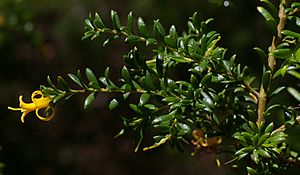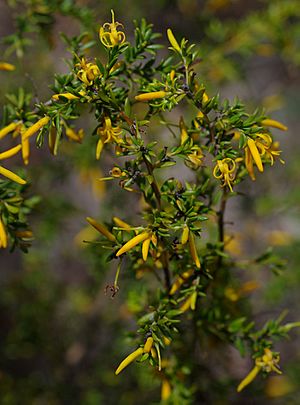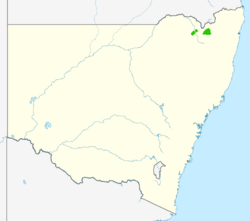Torrington geebung facts for kids
Quick facts for kids Torrington geebung |
|
|---|---|
 |
|
| P. t. terminalis at the Australian National Botanic Gardens | |
| Scientific classification | |
| Genus: |
Persoonia
|
| Species: |
terminalis
|
| Subspecies | |
|
|
| Synonyms | |
|
Persoonia nutans subsp. D P.H.Weston |
|
The Torrington geebung, also known as Persoonia terminalis, is a special kind of shrub. It is quite rare and belongs to a plant family called Proteaceae. You can find this plant growing naturally in eastern Australia, specifically in northern New South Wales and southern Queensland.
Scientists first thought it was a type of Persoonia nutans in 1981. Later, in 1991, two scientists named Lawrie Johnson and Peter Weston officially described it as its own unique species.
There are two main types, or subspecies, of the Torrington geebung: P. t. terminalis and P. t. recurva. Both grow in forests with tough, leathery leaves (called sclerophyll forests). They prefer well-drained soil that is a bit acidic. P. t. terminalis can also be found growing on rocky areas made of granite.
Even though these two types look similar, their leaves are different lengths and curve in different ways. Both types only grow in small areas. For example, P. t. terminalis is found in an area smaller than 100 square kilometers (about 38 square miles).
The Torrington geebung usually grows to about 1.5 meters (5 feet) tall. It can grow straight up or spread out. Its leaves are narrow and short, up to 1 centimeter (0.4 inches) long. The plant has yellow flowers that mostly bloom in December and January, which is summer in Australia. After the flowers, it grows green fruits with purple stripes. These fruits are called drupes and are safe for animals to eat. Wild animals help spread the seeds of these plants.
Contents
What is the Torrington Geebung?
The Torrington geebung is a type of plant that scientists have studied for a long time. In 1981, a scientist named Lawrie Johnson from the Royal Botanic Garden, Sydney first mentioned it. He thought it was a special type of Persoonia nutans, which was a very broad group of plants.
Later, in 1983, other scientists from Queensland thought it might be part of Persoonia oxycoccoides. However, they also believed it could be its own species because the plants in Queensland didn't quite match the description of P. oxycoccoides from central New South Wales.
How Scientists Named the Plant
After looking closely at Persoonia nutans and Persoonia oxycoccoides again, Lawrie Johnson and Peter Weston realized there were many different species. So, in 1991, they officially named Persoonia terminalis as a unique species.
The first plant specimen used to describe the species was collected near the Torrington pub in New South Wales. This important specimen is now kept at the National Herbarium of New South Wales. A herbarium is like a plant library, holding over 1.2 million dried plant samples!
The name Persoonia comes from a South African botanist named Christiaan Hendrik Persoon. The second part of the name, terminalis, means "at the end." This refers to how the flowers grow in clusters at the very ends of the plant's branches.
Different Types of Torrington Geebung
The Torrington geebung belongs to a group of 58 closely related Persoonia species. These plants have similar flowers but very different leaves. They can sometimes mix and create new types if they grow near each other. P. terminalis has been seen to mix with Persoonia cornifolia and Persoonia sericea.
There are two main subspecies of the Torrington geebung:
- P. t. recurva: This type has shorter leaves, up to 0.75 centimeters (0.3 inches) long. Their edges curve downwards more.
- P. t. terminalis: This type has longer, straighter leaves, up to 1 centimeter (0.4 inches) long.
What Does the Torrington Geebung Look Like?
The Torrington geebung grows as a shrub between 0.7 and 1.5 meters (2.3 to 5 feet) tall. It can grow straight up or spread out. Its bark is smooth, but new parts of the plant are covered in fine hairs.
The leaves are small and narrow, about 1.2 to 2 millimeters (0.05 to 0.08 inches) wide and 3.5 to 10 millimeters (0.14 to 0.39 inches) long. The top surface of the leaf is slightly rounded, and the edges curve downwards. New leaves might have a few hairs, but they become smooth as they get older. Both sides of the leaves are usually the same color, or only slightly different. The leaves of this plant are rougher than those of other Persoonia species.
Flowers and Fruits
The yellow flowers mostly appear in December and January, which is summer in Australia. Sometimes, you might see a few flowers as late as July. The flowers grow in groups of one to five at the ends of the branches.
Each flower has a tube-like outer part that splits into four sections. Inside, it has both male and female parts. The central part, called the style, is surrounded by four parts that curl back. These curled parts look like a cross from above and give insects a place to land. The sticky tip of the style, called the stigma, collects pollen.
After the flowers, the plant grows fleshy, green fruits with purple stripes. These fruits are called drupes. They are about 1 to 1.2 centimeters (0.4 to 0.5 inches) long and 0.7 to 0.8 centimeters (0.28 to 0.31 inches) wide. The remains of the style can still be seen at the end of the fruit.
Where Does the Torrington Geebung Grow?
P. t. terminalis is found in the Torrington-Binghi area of New South Wales. This is in the western part of the Northern Tablelands, about halfway between Glen Innes and the border with Queensland. It grows at high altitudes, between 900 and 1100 meters (2,950 to 3,600 feet) above sea level.
This subspecies likes acidic, sandy, or stony soils that come from granite. It grows in dry sclerophyll forests. The area has many granite rocks sticking out of the ground. Here, P. t. terminalis is part of different plant communities, like shrublands with plants such as Babingtonia odontocalyx and Brachyloma saxicola.
P. t. recurva grows in two separate areas. One is in New South Wales, near Warialda, which is northwest of Inverell. The other is southwest of Inglewood in southeastern Queensland. This type grows at lower altitudes, between 350 and 450 meters (1,150 to 1,480 feet) above sea level.
It prefers acidic, sandy soils that come from sandstone. It also grows in dry sclerophyll forests. In the Warialda State Conservation Area, you can find it in woodlands with black cypress pine and dirty gum trees.
Both subspecies are often found near the Severn River Nature Preserve and the Arakoola Nature Reserve. Here, they are part of a forest community with smooth-barked apple and long-fruited bloodwood trees, which grow on sandstone soils.
How Does the Torrington Geebung Live?
The Torrington geebung lives in places where bushfires happen often. For many plants in Australia, fire is very important for them to grow back.
P. t. terminalis plants are killed by bushfires. However, new plants grow from seeds that have been waiting in the soil. Many Persoonia seedlings appear after a fire. But if fires happen too often, like less than every five years, plants might not have enough time to grow up and make new seeds before the next fire. This can put them at risk of disappearing from an area.
Pollination and Seed Spreading
Special bees called Colletid bees, from the group Leioproctus, are very important for the Torrington geebung. They visit and pollinate the flowers of many Persoonia species. Other bees also feed on Persoonia flowers but don't seem to be as good at pollinating them.
The fruits of the Torrington geebung are designed to be eaten by animals. Animals like kangaroos, possums, currawongs, and other large birds eat the fruits. When they eat the fruits, they help spread the seeds to new places.
Can We Grow the Torrington Geebung?
Scientists and gardeners believe that growing the Torrington geebung in gardens could help protect it. If you wanted to grow this plant, it would likely need soil that drains water well. It would also prefer a sunny or partly shaded spot and acidic soil.
The Torrington geebung can handle strong frosts. It is expected to grow better in a temperate climate (where temperatures are not too extreme) rather than a subtropical one (where it's warmer and more humid).
Growing new plants from seeds or cuttings (small pieces of the plant) is usually how plants are propagated. However, Persoonia plants are generally very difficult to grow from seeds or cuttings. This makes it hard to cultivate them in gardens.
See also
 In Spanish: Persoonia terminalis para niños
In Spanish: Persoonia terminalis para niños




